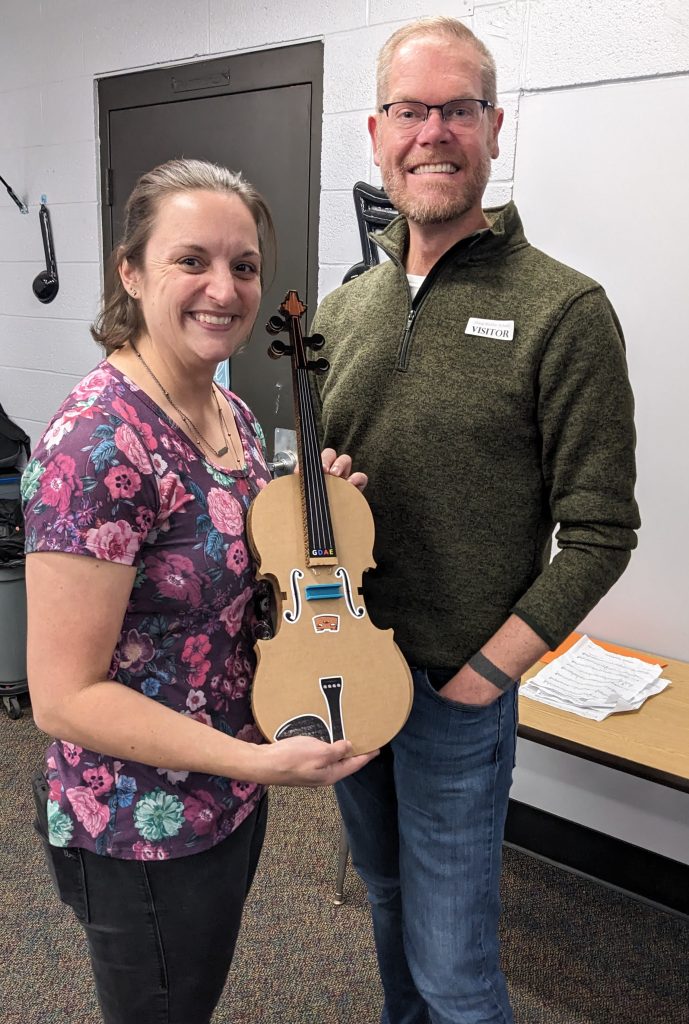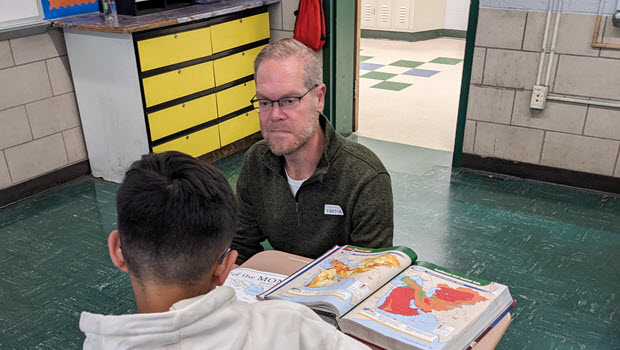Today kicks off CEA’s Bring Your Legislator to School Week with visits by state senators and representatives to classrooms across the state. Aside from legislators who are themselves educators, Education Committee Co-Chair Rep. Jeff Currey may be the legislator spending the most time in schools this week with visits to three Manchester schools today and more lined up for CREC, East Hartford, and Bridgeport schools later this week.
Currey is a firm believer in the need for legislators and local elected officials to get out and spend time in public schools. “We all went to school. It does not make us experts in education,” he says.
“You have to be able to hear directly from the people that you are trying to legislate for and on behalf of,” Currey continues. “When we can get into the classrooms, we can actually see how what we’re doing is impacting teachers, and that’s either giving them additional autonomy or giving them simply the resources that they need. If we don’t have to legislate things, then we shouldn’t. We shouldn’t just put things in statute for the sake of putting something in statue.”
“The goal for the week is for legislators to get firsthand experience and see what school today really looks like—not how it’s depicted in the media but what the day-to-day work for teachers and school for our students actually looks like,” says CEA President Kate Dias. “We want them to see the learning conditions, the opportunities our teachers are creating for our students, as well as the things that we could do with more resources and support. It’s about being able to see all the good that is going on but also the unmet opportunities that we could really seize.”
Currey began his Monday morning bright and early at Manchester High School. Classes start at 7:30, which meant an earlier morning for Currey than he’s used to, and he questioned whether the state should be looking at changing school start times. He discovered that a bus for a local high school stops outside his house—something he’d never realized before as he’s usually asleep when it picks students up.
At the high school Currey sat in on Shawn McClory’s statistics class where he found the windows open on a chilly morning that had yet to reach 50 degrees outside. Currey first wondered why the windows were open, but when students were cold and requested they be closed it quickly became clear. “Within five to 10 minutes, everybody was sweating—it was hot. One student looked like they were going to fall asleep, and it’s not a conducive learning environment when it fluctuates between extremes like that,” he said.
Currey said that the state has invested money in HVAC programs for schools and is trying to get money out to districts but that too often districts end up doing projects piecemeal rather than complete overhauls.
“I think we have to have some discussions about capital improvements long-term and short-term, and that often comes down to finances at the local level, so we need to get buy-in from parents and community leaders on that, first and foremost, because oftentimes school projects aren’t really prioritized in a town when it comes to putting that money forth through bonding and such,” he said.

Illing Middle School Orchestra Director Heather Sica-Leonard shows Rep. Currey a cardboard violin a class made so that students with significant physical and intellecutal disabilities can participate in the music program.
McClory said he wants legislators to know that education is not a one-size-fits-all model, and that to effectively teach students teachers need time and resources to thoughtfully plan and differentiate appropriately. “While the students are our number one priority, there are so many other responsibilities for teachers that it is difficult to find the time to do this to the best of our ability. There are also many teachers taking on second jobs, including coaching and other stipend positions to make ends meet. We want to be able to invest more energy into our classes and preparation.”
At Illing Middle School Currey visited several classrooms including that of Orchestra Director Heather Sica-Leonard who was leading her eighth grade orchestra students through a self-evaluation of a recording of their last rehearsal. She asked students to listen and write down what went well—their glow—and what they need to work on—their grow.
“I ask them to listen and think about, ‘What do you hear?'” she said. Sica-Leonard finds that approach to be much more effective than simply pointing out to students when a note is wrong. “I can’t sugar coat the recording, it’s just reality.” Students have only been rehearsing together for a few weeks, so they uniformly heard a lot of opportunity for growth.
“The work they’ll do between now and the concert—it will sound like night and day,” she said.
Sica-Leonard has taken on inventory management for the districts instruments to have better information about the instruments available to students. Some are older, of poor quality, and break frequently. She now tracks repairs and has three years of data to share with district leaders to be able to compare the cost of repairs vs. the cost of replacement. Seventy percent of students rent their instruments through the school, and even though the rental fee is only $60 a year, some families struggle with that. “We never want money to be a reason why we don’t have an instrument in a student’s hand,” she says.
“If I could get anything I would want for these students it would be to be able to replace all of the instruments in our inventory in fair or poor condition,” she continued.
Sica-Leonard’s enthusiasm for her job and her students is contagious. She shared her excitement with Currey about the school’s unified music program, now in its second year, which focuses on students with exceptionalities working with peer leaders. “This program is still in the developmental stages, but the focus is to reach students at their level through music—engaging in activities that support their needs. We have an amazing partnership with our unified PE/Sports program and have had collaborations such as song writing for ‘walk up’ songs for our kickball event and participating at our Unified Basketball event as our first ever ‘Hoop Band.’ Just last week, we had a Unified Football Game where the Unified Music students composed and performed their own drumline cadences.”
“There’s nothing better than seeing someone who loves what they do,” Currey remarked leaving her classroom.
Currey looks forward to visiting more schools this week and said that he encourages all teachers to make connections with their local elected officials on boards of education and finance and town council—as well as with their state representative and senator.
“Every educator should know who their delegation is in their hometown and in the town in which they teach, and they should not be timid,” Currey said. “I appreciate CEA offering up the opportunity to get legislators into the districts, and I hope more of my colleagues take them up on the offer as the opportunity comes up.”
If you’re interested in having a legislator visit your classroom this week, email CEA’s Government Relationship department at [email protected].







